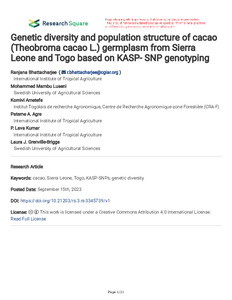| dc.contributor.author | Bhattacharjee, R. |
| dc.contributor.author | Luseni, M.M. |
| dc.contributor.author | Ametefe, K. |
| dc.contributor.author | Agre, P.A. |
| dc.contributor.author | Kumar, P.L. |
| dc.contributor.author | Grenville-Briggs, L.J. |
| dc.date.accessioned | 2023-11-27T10:41:01Z |
| dc.date.available | 2023-11-27T10:41:01Z |
| dc.date.issued | 2023 |
| dc.identifier.citation | Bhattacharjee, R., Luseni, M.M., Ametefe, K., Agre, P.A., Kumar, P.L. & Grenville-Briggs, L.J. (2023). Genetic diversity and population structure of cacao (Theobroma cacao L.) germplasm from Sierra Leone and Togo based on KASP-SNP genotyping. BMC Plant Biology, 1-21. |
| dc.identifier.issn | 1471-2229 |
| dc.identifier.uri | https://hdl.handle.net/20.500.12478/8340 |
| dc.description.abstract | Background Cacao (Theobroma cacao L.) is a tropical tree species belonging to Malvaceae family and originated in the lowland rainforests of the Amazon. It is one of the major agricultural commodities contributing towards the GDP (gross domestic product) of West African countries contributing about 70% of world’s production. Methodology A sample of 376 cacao (Theobroma cacao L.) germplasm accessions (235 from Sierra Leone and 141 from Togo) collected from different seed gardens and farmers’ fields across the cacao producing states/regions of these countries were assembled for genetic diversity and population structure studies using single nucleotide polymorphism (SNP) markers. The 376 cacao accessions were genotyped using 20 highly informative and reproducible KASP-SNPs markers. The genetic diversity among different accessions was assessed using three complementary clustering methods including the model-based population structure, discriminant analysis of principal components (DAPC), and phylogenetic trees. A network analysis was further carried out to understand the genetic relationships among cacao accessions from Sierra Leone and Togo. Analysis of molecular variance (AMOVA) was carried out to estimate the genetic differentiation among and within groups. Results The STRUCTURE and DAPC exhibited some consistency in the allocation of accessions in subpopulations or groups, although some discrepancy was identified in the grouping based on these two methods. Hierarchical clustering analysis grouped all the individuals into two major groups and represented several sub-clusters. AMOVA revealed high genetic diversity (86%) within accessions. A high rate of mislabeling/duplicate genotype names was revealed in both countries, which may be attributed to errors from the sources of introduction, labeling errors, and lost labels. Conclusion This study demonstrates the use of KASP-SNPs for fingerprinting that can help identify mislabeled accessions and provide strong evidence for improving the accuracy and efficiency in cacao germplasm management as well as distribution of correct materials to farmers. |
| dc.description.sponsorship | Swedish Research Council Development |
| dc.format.extent | 1-21 |
| dc.language.iso | en |
| dc.subject | Theobroma Cacao |
| dc.subject | Genetic Diversity |
| dc.subject | Population Structure |
| dc.subject | Single Nucleotide Polymorphism |
| dc.subject | Germplasm |
| dc.subject | Genotypes |
| dc.subject | West Africa |
| dc.title | Genetic diversity and population structure of cacao (Theobroma cacao L.) germplasm from Sierra Leone and Togo based on KASP- SNP genotyping |
| dc.type | Journal Article |
| cg.contributor.crp | Maize |
| cg.contributor.crp | Roots, Tubers and Bananas |
| cg.contributor.affiliation | International Institute of Tropical Agriculture |
| cg.contributor.affiliation | Swedish University of Agricultural Sciences |
| cg.contributor.affiliation | Institut Togolais de recherche Agronomique |
| cg.coverage.region | Africa |
| cg.coverage.region | West Africa |
| cg.coverage.country | Sierra Leone |
| cg.coverage.country | Togo |
| cg.coverage.hub | Headquarters and Western Africa Hub |
| cg.researchtheme | Biotech and Plant Breeding |
| cg.researchtheme | Plant Production and Health |
| cg.isijournal | ISI Journal |
| cg.authorship.types | CGIAR and developing country institute |
| cg.iitasubject | Agronomy |
| cg.iitasubject | Cocoa |
| cg.iitasubject | Food Security |
| cg.iitasubject | Genetic Improvement |
| cg.iitasubject | Plant Breeding |
| cg.iitasubject | Plant Production |
| cg.journal | BMC Plant Biology |
| cg.notes | Open Access Journal |
| cg.accessibilitystatus | Open Access |
| cg.reviewstatus | Peer Review |
| cg.usagerightslicense | Creative Commons Attribution 4.0 (CC BY 0.0) |
| cg.targetaudience | Scientists |
| cg.identifier.doi | https://doi.org/10.21203/rs.3.rs-3345739/v1 |
| cg.iitaauthor.identifier | Ranjana Bhattacharjee: 0000-0002-5184-5930 |
| cg.iitaauthor.identifier | Paterne AGRE: 0000-0003-1231-2530 |
| cg.iitaauthor.identifier | P. Lava Kumar: 0000-0003-4388-6510 |
| cg.futureupdate.required | No |

